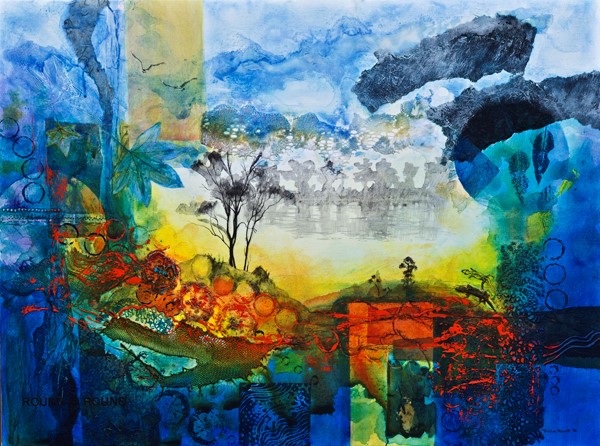
Tricia Reust: “Round and round”
Catalogue Essay by Geraldine Wheeler
“The Journey” Catalogue Essay
“The Journey” is a term open to a wide range of interpretations.
The works in this exhibition make reference to biblical journeys, long and short, to personal journeys, outward and inward, including lifelong journeys, and also the terrain across which the journey passes, literally or emotionally. Often there are multiple references with symbolism which overlaps these different references to the journey.
The Hebrew Bible/Old Testament story of Moses is the reference for Peter Hunter’s At the start of the journey there was WOMAN and he makes reference to the story of Jesus in Gethsemane and his prayer in Why? Should I drink the cup? Both works also use cross-cultural references, to ancient Egypt and the daughter of the Pharaoh in the former, and indigenous Australians in the latter. Jennifer Evans suggests the whole journey of Jesus in her Journey as we study the sandalled feet, while Geraldine Wheeler refers to the refugee flight of the Holy Family into Egypt while also making reference to the way other artists have suggested brutal killing and the agony of those whose lives are ruptured, Ian Fairweather’s panels of the slain children of Bethlehem in Epiphany (QAG) and Picasso’s protest against the Nazi bombing of Guernica in 1937.
Other biblical references are found in Dianne Minnaar’s The Good Shepherd icon, the Good Shepherd who accompanies her life’s journey, Sarah Douglas’ The Journey, long and ugly, with reference to Luke 10:19, showing the feet which will overcome many dangers, and Elisabeth Murray’s While you were gone which interprets the parable of Matthew 25: 14-30, how the servants use their “talents” while the master is away on a journey. Jennii Gould, on one hand, expresses the personal story with all its challenges (in a style she uses for her writing and illustrating of children’s books) and, on the other, also alludes to the story of Matthew 14:29 where Peter steps out of the boat to walk towards Jesus on the water and then succumbs to fear.
The personal journey is depicted in several ways by different artists, that journey with its highs and lows, successes and failures, light and dark times, a journey which often seems to go round and round in circles. Joy Harris presents a tangle of threads in abstraction, in a range of colours, but also includes precisely drawn symbols of hope and light, the butterflies and the lamp. Susan Pietsch, using the round, black backing board offers us glimpses of stages in the journey, certainty, doubt and the struggle but the will to journey on in the series of three, Life turns. This movement and turning of life is also conveyed in the works of Tricia Reust, particularly in Round and round but also in Trinity on the wing and Dust to dawn. These works use the brilliance of strong colour, particularly blue and yellow/gold, in patterns of abstraction together with the careful drawing of symbolic figures and objects. Brooke Smith’s triptych of figures and forms in Physical journey makes reference to the psychosomatic nature of our experience, the mind and body experience of the journey of growing older.
Barbara Niczynski suggests many details of the “soul journey” in Labyrinth, Turn left for rest stop, and Escape, using both the ancient symbol of the twisting path of the labyrinth, which is a path for prayer and reflection, and modern objects, perhaps suggesting our need to escape from the machine at times. The journey involves movement, both physical movement and the movement in every present moment of looking back, remembering, and looking forward towards the as yet unknown future. We see this expressed in Sharon Robert’s two works, Looking back –Portsea March 1971 and Looking forward.
Sue Oliver offers us a range of points of reference for the journey, the abstraction of the repetition of bundles of handmade paper and timber assemblage in The eighth day, the strong images of The ancient paths with reference to both the earth and the sky and the story of her contact with the Sisters of Mercy, starting the childhood music lessons, and the impact of that on her journey in life. Gregg Nowell references words of Jesus with Consider the wild flowers and then, in Watching, the sparrow, as he remembers his encounter with one such tiny bird during a journey to America. The bird, the crumb and the varied thin line in the carefully textured surface of the canvas offer opportunity for sensitive reflection on encounters offered along the path of the journey.
Beside this we see the beautiful face of the young woman looking out Around the corner, as Ruth Elvery titles this painting. During the journey we look out onto the world and Sometimes a light surprises. Drawing inspiration from William Cowper’s poem, Ruth groups two pairs of small acrylic paintings with this theme.
The artist who most gives us a focus on the context for the journey, the terrain over which we may travel, is Roslyn Hartwig with her two superbly worked watercolours, Let the river reveal the ancient path and Gentle song whispers through the hills. Nature (the river and the sounds, the song) also makes a journey, as do human beings with and in the natural world. Roslyn’s third work, The Trek, suggests the human journey.
This exhibition contains a beautifully diverse group of works, diverse in the treatment of the theme and diverse in the media by which that theme, “The Journey,” has been interpreted.
Our thanks to the Australian Catholic University, McAuley Campus, for the opportunity to hold this exhibition in the P. W. Sheehan Gallery, facilitated by Assoc. Prof. Lindsay Farrell.
Geraldine Wheeler for Visionaries, 2016